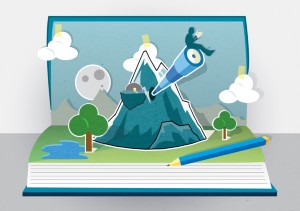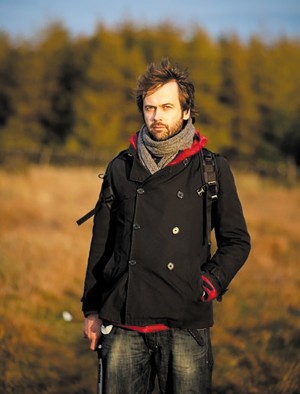The creative process of writing science-inspired fiction can be rewarding — and the untapped niche is rich in opportunities for originality.
When Steve Caplan was a graduate student in the late 1990s, he accidentally inhaled a toxic chemical in his immunology laboratory, and had to spend ten days at home to recover. With little to do, he began to write a novel — he loved reading and had published some short stories, but hadn't yet had the time or mental space to produce longer work. He pounded out most of a rough draft about a scientist struggling to get tenure and coping with childhood memories of a parent with bipolar disorder.

After going back to work, Caplan — now a cell biologist at the University of Nebraska Medical Center in Omaha — spent months revising the manuscript at night and on weekends. His initial attempts to sell the novel to a publisher failed, but in 2009, he decided to pursue the self-publishing route. Caplan produced print and electronic versions of his novel using the Amazon services CreateSpace and Kindle Direct Publishing, and publicized the work by doing readings at bookshops and libraries. He collaborated with his university's public-relations office on a press release, and showed a slide of the book at the end of his seminars. The novel, called Matter Over Mind (Steve Caplan, 2010), has sold more than 2,000 copies so far, netting roughly US$7,000. He has since written two more novels, which he published through small presses, and is now working on a fourth.
For many scientists who spend their days cranking out papers and grant proposals, writing fiction may seem like the last thing they would want to do. But some researchers with a love of literature have made time to pursue the craft — and have found it creatively rewarding. Science offers plenty of rich material, whether it is the drama of overwintering at a polar research station or the futuristic thrill of genetically engineering live organisms. “You're sitting on a gold mine of really interesting stories,” says Jennifer Rohn, a cell biologist at University College London and founder of LabLit.com, a website about portrayals of scientific research in fiction and other media.
A tantalizing niche
When done well, science-related fiction can help to expose the public to the scientific process, humanize researchers and inspire readers to learn about topics they might otherwise ignore. Such nuanced depictions of science in fiction are relatively rare. LabLit.com has catalogued about 200 examples of novels, such as Barbara Kingsolver's Flight Behavior (HarperCollins, 2012) and Ian McEwan's Solar (Random House, 2010), that feature realistic scientists as characters. Stories about scientists are well outnumbered by those about, for example, doctors or artists. Even science fiction tends to lack portrayals of the actual scientific process, says Alastair Reynolds, a science-fiction author near Cardiff, UK, who left a career in astronomy to write full-time.
The shortage of works with accurate depictions of science means that researchers who write fiction have a good opportunity to be original — a task that would challenge an aspiring crime or romance writer. “It's sort of untrampled ground,” says Rohn. Many researchers are familiar with fieldwork sites and unusual settings that other writers might not have at their fingertips. In her novel The Falling Sky (Freight Books, 2013), Pippa Goldschmidt, an astronomer turned fiction writer in Edinburgh, UK, writes about a young astronomer who wanders into a telescope dome on a Chilean mountaintop and is nearly injured when the operator moves the instrument.

Sources of plot inspiration abound in science. Reynolds reads research news and papers voraciously for intriguing elements that can be parlayed into fiction. One time, he found a study about huge flocks of starlings in which the authors used high-tech equipment to track individual birds. He incorporated the idea into a science-fiction story, but made the fictional technology so advanced that it could track the birds' eye movements.
Scientists also can draw ideas from the past. Goldschmidt was inspired by an anecdote about physicist J. Robert Oppenheimer: during an unhappy period in the 1920s while studying abroad, Oppenheimer left a poisoned apple for his tutor. The details are sketchy, but Goldschmidt wanted to imagine what might have transpired. “No historical figure is ever completely understood,” she says. “There's always gaps in their lives, and fiction can inhabit those gaps.” The result was a short story entitled 'The Equation for an Apple', a fictionalized account of Oppenheimer's life leading up to the act.
Scientist–writers can also generate ideas by doing something they are already used to — sitting around and imagining scenarios, notes Andy Weir, a novelist in Mountain View, California. His novel The Martian (Crown, 2014) explores what might happen if a crewed Mars mission goes awry and one person is left behind on the red planet. The story follows the lone astronaut's trials as he tries to grow enough food for himself and to make contact with Earth.
Fiction-writing classes offered through adult-education programmes or at creative-writing centres can help authors to transfer an idea onto the page. These courses provide basic tips, such as how to construct compelling characters, build tension and handle shifts between past and present. Participants often critique each other's manuscripts, giving scientists a chance to get feedback from non-technical readers.
Reading widely and critically helps, too. Reynolds learnt to write fiction by studying the differences between his writing and that of successful authors. To work out how to rotate between different characters' points of view, he read James Ellroy's crime novel L.A. Confidential (Mysterious Press, 1990). And writers can learn how to structure dialogue from masters such as Jane Austen, he says.
Opening act
Short stories are a good starting point because newbies can quickly practise the basics, explore story ideas and learn from their mistakes. But, Goldschmidt notes, “there's no point in writing short stories if you don't like reading them”. Scientists who want motivation to complete a longer work might consider participating in National Novel Writing Month, an international programme held every November that encourages writers of all levels to produce a 50,000-word manuscript (see nanowrimo.org). Researchers can also find support through collaboration with professional writers on works of fiction (see 'Meeting of the minds').
boxed-textResearcher–writers should keep in mind that education is not the main purpose of fiction. Technical details should be included only if the reader needs them to understand the story, not simply because the author finds them fascinating. For The Martian, Weir went to great lengths to ensure accuracy, and even performed orbital-dynamics calculations. But he left out how he came up with certain numbers, such as the mass that had to be removed from the ship to achieve escape velocity.
When technical information is necessary, writers should try to deliver it in a way that sounds natural. “People don't tell each other a whole bunch of information about particle physics when they're having breakfast together,” says Goldschmidt. Instead, she tries to make the science an organic part of the character's personal journey. In the Oppenheimer story, the physicist thinks about an experiment that he is trying to replicate, but the details are woven into his emotional turmoil at failing to complete it.
Humour can help to lighten the tone. The Martian's protagonist is a smart-aleck, and his jokes break up the expository text. In one section, he says that if he were exposed to damaging solar radiation, he would “get so much cancer, the cancer would have cancer”.
The path to press
Many outlets accept short-story submissions. LabLit.com often publishes fiction by scientists, although it does not pay them because it is a volunteer effort. Nature runs an 850- to 950-word science-fiction story each week (see nature.com/futures). The website Duotrope.com offers a searchable database of literary journals and other fiction markets around the world, and writers can peruse newsstands for sci-fi magazines such as Analog Science Fiction and Fact.
For longer works, small presses are a more-realistic option than major publishers, and many do not require writers to have agents. Tasneem Zehra Husain, a theoretical physicist and writer in Cambridge, Massachusetts, wrote a novel that revisits physics breakthroughs throughout history from the perspectives of fictional characters. Through an acquaintance, she connected with the publisher Paul Dry Books in Philadelphia, Pennsylvania, which released her book Only the Longest Threads last year. To find small presses, scientists can look for companies that have published similar books. Alternatively, authors could self-publish using a service such as Lulu.
Many literary journals do not pay at all, and Reynolds estimates that science-fiction magazines have paid him an average of only US$200–300 per story. But the contacts that Reynolds made through short-story publishing led to a book deal, and he published four novels while working as an astronomer. By the time he quit science to become a full-time writer, he was making about $60,000–$75,000 per year from book sales.
The write balance
Few scientists can expect to make a living — or earn much — from their fiction. But money often isn't the main motivation. Caplan, for his part, wanted to bring attention to the challenges faced by the family members of people with bipolar disorder (challenges he himself has experienced) and to provide entertainment for scientists. He also finds that writing fiction clears his head, in the same way that playing a sport might do for others (see Nature 523, 117–119; 2015). “It's almost like a form of meditation,” says Caplan. “It just keeps me sane.” And there are other rewards. Scientists have a chance to reach people who might not read a non-fiction science book or visit a natural-history museum — but who might read a love story about ecologists in an exotic field location. And readers might be inspired to look up the science once they've finished.
Scientists have a chance to reach people who might not read a non-fiction science book or visit a museum.
There can also be a cross-training effect. Rohn thinks that her fiction has helped her to get more grants; reviewers have commented that her proposals are beautifully written. The craft of telling a story applies to scientific papers as well; in hers, for example, she lays out the phenomenon that her team noticed, the questions it raised and what they did to try to answer those questions. “Everybody wants to hear a story,” she says.
Finding the time to write is a challenge. Some scientists squeeze it in on evenings and weekends. Husain wrote her book while working part-time, and says that she could not have done so with a full-time job because the novel required extensive historical research.
Scientist–authors also risk having their fiction perceived as a distraction by promotion committees. Husain worried that her novel might affect her career prospects. But she has received positive feedback on the book from other physicists, including prominent researchers whose fields are described in her book.
For researchers who delve into fiction writing, the act of creating a world, characters and stories can be intensely rewarding. When the writing is flowing, says Rohn, “it's like being caught up in the best book you've ever read”.
Author information
Authors and Affiliations
Related links
Related links
Related links in Nature Research
Q&A: David Brin on writing fiction
Nature blogpost: How to write for Nature Futures
Nature blogpost: Transitions — combining science and novel writing
Nature blogpost: More bang for your book
Nature blogpost: Plotting a role for scientists in fiction
Related external links
Rights and permissions
About this article
Cite this article
Kwok, R. Creative writing: A world of pure imagination. Nature 525, 553–555 (2015). https://doi.org/10.1038/nj7570-553a
Published:
Issue Date:
DOI: https://doi.org/10.1038/nj7570-553a
